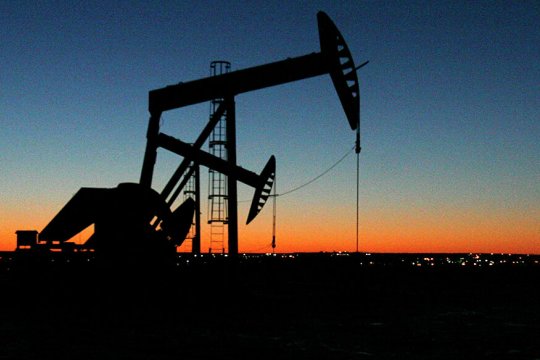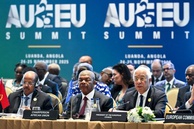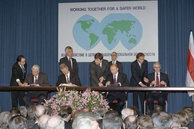The collapse of the OPEC+ deal, coupled with a drop in demand amid the raging coronavirus pandemic, has sent tectonic shocks across the global oil and gas markets. Simultaneously, attacks on the Nord Stream-2 gas pipeline project have intensified again.
The global demand for oil had started to decline well before negotiations on the possibility of OPEC+ extension got under way in Vienna at the beginning of March. The decline was due to the pandemic and warm winter. In the course of Vienna talks Riyadh issued an ”ultimatum-like demand” for a dramatic reduction in oil production, which was unacceptable for a whole number of supplier countries because of the risk of losing their share of the market. Meanwhile, accusations on the part of Saudi and western politicians and mass media who blame Moscow for initiating the OPEC+ failure are groundless. Cartel agreements naturally lose their attractiveness over time, since «every participant tends to cheat on others». Another substantial flaw of the OPEC+ is that there are no oil companies from the United States among its signatories. As a result, the reduction in oil production on the part of OPEC+ countries has increased the market share of American producers.
In response to the OPEC+ fiasco, Saudi Arabia (KSA) announced its intention to “inundate the market” by boosting the output by 25%. Riyadh launched a price war in the hope of “regaining the lost share of the market”. KSA cut the oil prices it offered for April by 5-8 dollars per barrel in an attempt to exert pressure on Russia and “on other producers, which are not members of OPEC, including the United States». A number of Gulf countries have also announced an increase in production. As a result, by the end of March, oil prices had reached an 18-year low, the Russian Urals[i] hitting less than 15 dollars per barrel. Should the price war escalate, the Urals price may drop to 5-8 dollars.
Observers present different comments as to Riyadh’s reasons for doing so. From purely tactical considerations – «to force Moscow to return to the negotiating table», to long-term ones, oriented at re-carving the entire oil and gas market, including destabilization of the oil industry of competitor countries, first of all, Russia and the United States. It could even be an attempt to undermine the social and political stability in economies which are dependent on oil and gas exports.
The Saudis’ major advantages comprise, first of all, the lowest production cost, huge oil reserves, substantial, over 0.5 trillion dollar state reserves, and unlimited opportunities for foreign loans. At the same time, experts say, «the Saudi economy is bogged down in debt»[ii]. If it wants to maintain deficit-free budget, Riyadh ought to keep prices at no less than 80 dollars per barrel. According to IMF experts, even a return to «the rate of 50-55 dollars per barrel» will not be enough for KSA.
By 2024, Saudi Arabia may face a balance of payments crisis and could choose not to tie the rial to the dollar [iii]. Meanwhile, on March 27, The Wall-Street Journal reported mass consumer refusals in Europe and North America to accept new shipments of Saudi oil, as “there is nowhere to store more of it.”
The dramatic decline in oil prices has seriously hit the US oil business, as fears of mass bankruptcies in the American shale oil production sector build up. Regular suppliers are preparing to significantly reduce investments and supplies.
The “shale boom” made it possible for America to surpass Saudi Arabia and Russia in 2018 and become the world’s largest oil producer. Unlike earlier, when cheap oil always played into the hands of the American economy, now the situation has changed radically. In the conditions of the coronavirus pandemic, the money saved by gasoline consumers is unlikely to whip up demand in other sectors of the economy. What will sustain damage as well is the shale oil sector on which a number of US states depend. The breakeven threshold for shale oil companies, according to The Economist, varies from $ 23 to $ 75 per barrel, depending on the oil basin. The price collapse is fraught with mass layoffs - right in the year of the presidential election.
Meanwhile, shale oil producers have experienced mounting difficulties even before the start of the current price war. Many companies have been reporting only losses in balance sheets of late. Investors have turned away from the shale sector, most companies found it almost impossible to draw new loans or refinance the old ones. Now, given the dramatically developing situation in the oil market, many shale producers may see being taken over by larger players as the “best” option.
The collapse of oil prices has dealt an equally devastating blow to the geopolitical plans of the US leadership. As dependence on oil imports decreased, Washington became ever more confident that the United States would now be able, through sanctions, to completely halt oil exports from Venezuela and Iran, without fearing uncontrolled global destabilization. A number of experts in Russia express concerns that the growth of production and export capacities in LNG and shale oil sectors, according to the standard scheme now, could prompt Washington to “tighten sanctions” against the Russian oil and gas industry.
In the summer of 2017, President Trump announced plans to secure a US dominant position in the global gas market. An energy strategy that saw light at that time as well “describes Russia as a competitor,” claiming that “Russian projects to diversify supply routes to Europe run counter to the US policy.” Resulting from such political approaches is “concerted effort ... against Nord Stream-2 (NS-2)” and other Russian projects on the construction of new gas pipelines to Europe [iv].
At the end of 2017, the United States, for the first time in 60 years, began to export more gas than it imported. The growth of shale production enabled the United States to produce 733 billion cubic meters by the end of 2017 – more than anywhere in the world, including Russia [v]. However, until recently, one of the major obstacles to expanding US gas exports was the US dependence on oil imports. Oil in the US domestic market is several times more expensive than gas in energy equivalent. If the US is to increase the supply of its "cheap" gas - to compensate for the shortage of oil and gas in the domestic market - it would have to increase the import of "expensive" oil.
Another deterrent is competition from Russia. American LNG is more expensive than Russian pipeline gas. As a result, in 2017, gas supplies from the USA to Europe amounted to no more than 3 billion cubic meters of gas. Meanwhile, gas consumption in Europe last year reached 500 billion cubic meters. [vi]. In an attempt to reverse the trend, in the same 2017, the US Congress voted in favor of a package of sanctions that put under “threat the construction of any new gas pipeline” in Europe with the participation of Russia. In general, it was supposed to launch sanctioned weapons against Moscow by the time the LNG production in the USA reaches full capacity - by 2020-2022. On December 21, 2019, when the United States imposed sanctions against companies engaged in laying NS-2, foreign project contractors suspended all operations.
It cannot be ruled out that if and when the EU sees American LNG as a good alternative to Russian gas, Brussels may choose to swap restrictions on gas supplies from Russia to Europe. The political will to “pay extra for energy security” is also present in a number of European countries. Another scenario could feature a US attempt to force a price war on Moscow, to guarantee dumping in the European direction. In this case, Nord Stream-2 will fall not only under political, but also under direct financial pressure. But it’s hard to imagine how the US authorities are going to convince their power engineers to supply Europe at a loss?
Meanwhile, the long-term strategy of the United States, according to a number of Russian analysts, may not boil down to the struggle for the gas market, but for its transformation by analogy with the oil market. If it were possible to block the maximum number of existing and under construction pipelines, the lion's share of gas in the world would go by sea in the form of LNG. This would help “untie” gas prices from oil and transform the international gas market into a single, global and spot one [vii] where transactions are quick and are made in US dollars to minimize costs and risks. Thus, the main goal of the hype around the “shale revolution” and the “seizure of the global gas market” is to keep the global oil and gas market tied to the US dollar [viii].
The price war declared by Saudi Arabia may put an end to such plans. That the situation in the United States has reached a critical point becomes clear on the basis of recent statements from Washington. According to US media reports, on March 26, the US Secretary of State called on Saudi Arabia to “stop the price war with Russia” [ix]. Texas shale producers have urged state officials to “consider reducing oil production ... due to falling demand” [x]. On March 30, at the initiative of the White House, there was a telephone conversation between Vladimir Putin and Donald Trump. The two parties agreed to hold “Russian-American consultations” “on the current state of the world oil market” “on the level of ministers of energy” [xi]. Markets took the news with some hope of concluding a comprehensive agreement on the regulation of oil production between Moscow, Washington and Riyadh.
Europe, in the event of further blockage of the Nord Stream 2 project, risk falling hostage to Washington's geopolitical ambitions, what with its statements about the intention to fill the market with its LNG. But this may undermine the economic leadership of Germany, and, accordingly, the policy of strengthening EU unity. Finally, if, after all the current cataclysms, the European Union is still adamant to fight for energy independence, it will have to think how to reduce the share of international commodity trade in dollars. Back in September 2018, the then head of the European Commission, Jean-Claude Juncker, said it was “absurd” for the EU to pay for 80% of its energy imports in dollars, considering that these imports are estimated at 300 billion euros per year. And this is despite the fact that only 2% of Europe’s energy imports come from the United States.
Rumors circulating in the oil market are about the possibility of behind-the-scenes agreements between the United States and Saudi Arabia, which will be directed against Moscow. At the same time, The Financial Times writes, “Russia's major oil companies have every chance of surviving a drop in oil prices over the next two years, taking into account the advantages that they have over foreign competitors.” For example, Russian oil companies will remain profitable even at a barrel price of $ 15.
Significantly, the ability of the Russian fuel and energy complex to effectively resist price fluctuations is largely the result of Western sanctions. For example, “a large part of the costs and debts” of Russian oil companies is denominated in rubles. At the same time, the ruble exchange rate is free, “floating,” while the currencies of the KSA and the UAE are tightly tied to the dollar. The decline in the ruble leads to an increase in export revenues. The Russian tax system flexibly responds to falling oil prices. Finally, “the country's oil companies have built up large foreign exchange reserves in recent years” [xii].
Russia's positions in the European gas market remain strong as well. Despite the year-on-year increase in political and sanction pressure, as well as the decline in contract prices, Russia accounts for a third of the European market. The Russian leadership, as well as Gazprom, have repeatedly emphasized their commitment to completing the Nord Stream 2. The energy strategy of Russia until 2035 provides for the progressive development of new projects in the LNG sector, where world trade is expected to increase to 70% by 2040.
Thus, the current state of the global oil and gas market is determined by three key factors: the price war, the coronavirus pandemic and, as a result, an excess of oil supply. In addition, the situation in the world economy may break the sad "records" of the 2008-2009 crisis. According to the estimates of the Xinhua News Agency, the whole world is "in survival mode." In such circumstances, each of the supplier countries faces a dilemma: to fight for a greater market share in the hope of beating the competitors, or try to coordinate efforts to stabilize prices. It seems that the struggle for exhaustion is the last thing the world community needs now. For this reason, Moscow calls for dialogue and a return to constructive cooperation, which hinges on a thorough analysis of the long-term consequences of decisions made.
The opinion of the author may not coincide with the position of the Editorial
[i] Urals, in most transactions, is sold at a discount of $ 4-8 to the Brent “benchmark” brand.
[ii] https://inosmi.ru/politic/20200330/247159435.html
[iii] https://inosmi.ru/economic/20200326/247132125.html
[iv] http://expert.ru/2017/06/29/energeticheskoe-dominirovanie/
[v] Now, according to lenta.ru, America accounts for 21 percent of global gas production, Russia - 16 percent.
[vi] http://expert.ru/2018/07/18/vstrecha-v-helsinki----nachalo-gazovoj-vojnyi-za-evropu/
[vii] Spot - settlement conditions under which payment for a transaction is made immediately (usually within two days).
[viii] http://expert.ru/expert/2017/37/trubyi-goryat/
[ix] https://inosmi.ru/politic/20200326/247138727.html
[x] https://www.vedomosti.ru/business/articles/2020/03/31/826728-slantsevie-sokratit-proizvodstvo
[xi] http://kremlin.ru/events/president/news/63086
[xii] https://inosmi.ru/politic/20200330/247162614.html
read more in our Telegram-channel https://t.me/The_International_Affairs

 12:34 08.04.2020 •
12:34 08.04.2020 •



























